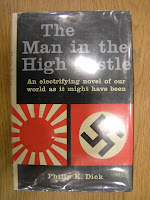I'm sitting in the reading room at the Lilly right now. I've finished my projects, but I won't have completed my hours until noon. I put the final flags in the John Ford exhibit and handed the paperwork over to conservation. I put copies of the paperwork for my sci-fi exhibit with the materials and replaced a few missing flags. It's been a long semester and I've done a lot of work, and it's a little bittersweet to see it go. I spent the last two weeks immersed in John Ford, both here with writing the labels for the movies, and at home with watching the movies. I answered a few reference questions early in the week and brought in a little money because all of the patrons wanted copies of the materials. So to now sit here with nothing to do feels odd, and makes me think about what I have done all semester.
Reference:
I learned how to use the various reference materials that the Lilly has to offer: finding aids, collection guides, the physical card catalog. Each of them was useful, though not perfect. I spent a lot of time going through boxes, pulling materials. One of my first solo reference questions was for pictures of John Ford with his family and Katherine Hepburn. At the time, I was excited to be working with photographs and couldn't imagine that by the end of the semester, Becky would have turned the curation of an exhibit on Ford entirely over to me. My favorite thing I learned from my reference work was that James Whitcomb Riley went by Jamesy.
Outreach:
One of my favorite activities at the beginning of the semester was working with Becky when she presented to classes. I just got to sit off to the side and watch until the end, when I helped her pack the things away. Once and awhile I'd grab supports or weights for her. It was fun watching the students interact with the collections, particularly when they were impressed. When I finally got the opportunity to talk about library materials with students, they were fifth graders, not undergrads, and it was almost the most fun I had all semester. Special collections are absolutely wonderful, and I enjoyed being a part of helping other people learn this.
Science Fiction:
A large part of the semester was taken up with my personal project, curating an exhibition on science fiction authors, a topic the Lilly is uniquely suited to support. Looking through the papers of Anthony Boucher (aka William Anthony Parker White) and reading letters by some of the sci-fi writers I grew up hearing about was just phenomenal.
The work even inspired me to get back to reading science fiction, and I have worked my way through works by these authors since. The other gratifying part of this project has been the reaction when I tell people about it. Science fiction has always been a fringe genre, beloved of nerds and geeks. So, naturally, I was surprised when the reaction to my topic (from people outside my immediate family) was favorable. Many people seemed to even think it was cool :) I know that today is being dedicated by geeks the country over to
a girl named Katie who was bullied for carrying a Star Wars water bottle to school. Well, Katie, there are plenty of us out there (and tons of us are girls), and when you grow up I know you'll find your people (I apparently did).
John Ford:
The semester ended with a return to John Ford. When I went into my sci-fi exhibit, I may not have read most of the books I was including, but I knew what I was doing because I was familiar with the authors and the genre. As for John Ford, not only had I never seen a single one of his films (with the exception of the clips in "Movie Tonight"), I had never seen a Western (well, a real Western.
Blazing Saddles, "
A Fistful of Datas" and "
Living in Harmony" don't count). Four of the movies chosen to be featured in the exhibit were Westerns. Well, I learned something new. I learned I like Westerns. I would even call
The Man Who Shot Liberty Valance one of the best movies I've ever seen. And if it weren't for this work, it might have been a long time, if ever, before I was finally introduced to Ford's films and Westerns.
After I eat lunch, I will be coming back to the Lilly...to train for working the reading room desk next semester. It's nice that this internship got me a job. But it's fantastic that I got much more out of it than that.












